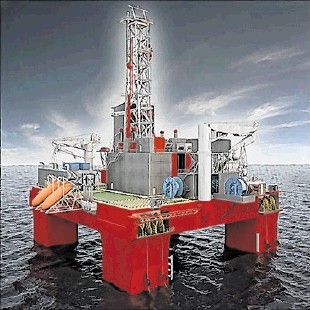
Aker Solutions has won a long-term contract that could be worth up to $1.9billion to build and operate an entirely new type of semi-submersible drilling rig that Statoil says will make an “important contribution” to raising recovery rates from existing North Sea oil and gas fields and slashing well intervention costs.
Expectation is that the novel rig will enter service in 2015.
In cooperation with its supply chain, Statoil has developed a rig and well control system specially adapted to carry out well intervention and drilling operations in existing subsea wells.
The so-called category B rig with associated integrated services is expected to reduce operating costs for well intervention by as much as 40%. This is a huge reduction and offers the potential to significantly lift recovery levels from fields where Statoil has an interest.
This is the third new type of drilling rig design launched on to the marketplace by the semi-state-owned Norwegian petroleum company of late.
A number of category D semi-submersibles are already on order through Songa Offshore, while tendering for at least two category J jack-ups is expected to start mid-year.
Tendering for the category B design started in 2010 and was extended in March last year.
Category B, is designed and equipped for the “industrialisation” of drilling and intervention services in existing production wells and represents a new sort of service. According to Statoil, this new design slots into a space between light intervention vessels (category A) and conventional rigs (category C).
Traditional drilling rigs are not considered efficient enough for well intervention purposes.
It is an important piece of Statoil’s rig strategy, which appears increasingly based on tailored vessels and rigs for various operations.
“This will be a very important part of the toolbox for increased recovery on the Norwegian continental shelf, making it possible to produce oil and gas that otherwise would be lost,” said Statoil technology, projects and drilling VP, Margareth Øvrum. “The category B rig is the result of long-term, targeted technology development to increase subsea well recovery rates.”
Only Petrobras currently eclipses Statoil in its ambition to build a fleet of high-tech, efficient offshore drilling rigs, and many of those will have Norwegian involvement.
All other oil majors appear content to hire what drilling contractors offer, though they frequently influence the manner in which new units are kitted out during build and prior to going on to long-term contracts.
This latest order assures Norway’s position as a global leader in the design, build and operation of sophisticated offshore rigs. This tiny country now challenges the pre-eminence of the US in this market. The UK barely figures in this market.
The Aker Solutions Category B contract will run for eight years, with options for three times two years. In addition to rig rental, the contract also includes rental of the necessary equipment and services to carry out well intervention, sidetrack drilling, ROV (remotely operated vehicle) operations, well testing and cementing.
The category B design with integrated services is based on Aker Solutions own studies with a background in Statoil specifications. The rig type is designed for year-round well servicing and will be capable of a number of different types of well interventions using wireline and coiled tubing operations.
It has also been designed to carry out sidetrack drilling from production tubing (through tubing drilling – TTD) in a manner that allows simultaneous production from both the new sidetrack and existing production tubing. The well services are conducted through existing subsea Christmas trees.
The key to maintaining the current production level on the Norwegian Continental shelf (NCS) is increased recovery from existing fields, along with the development of new fields. Increasing drilling activity on mature fields is important in order to achieve the NCS’ full potential. Unlike the more mature UK sector where fiscal mismanagement has contributed to plummeting output, Norwegian oil production is now relatively flat after several years of moderate decline, while gas production continues to rise.
In Norway’s case and according to Ivar Aasheim, Statoil’s senior VP of field development, new and improved well service methods provide a substantial contribution to increased recovery on the NCS.
“Statoil currently operates around 500 subsea wells, and we need efficient tools to maintain these,” he said.
“Collaboration between many licences has been a precondition for establishing a long-term work programme. We therefore thank our licence partners for enabling us to realise the category B service together.”